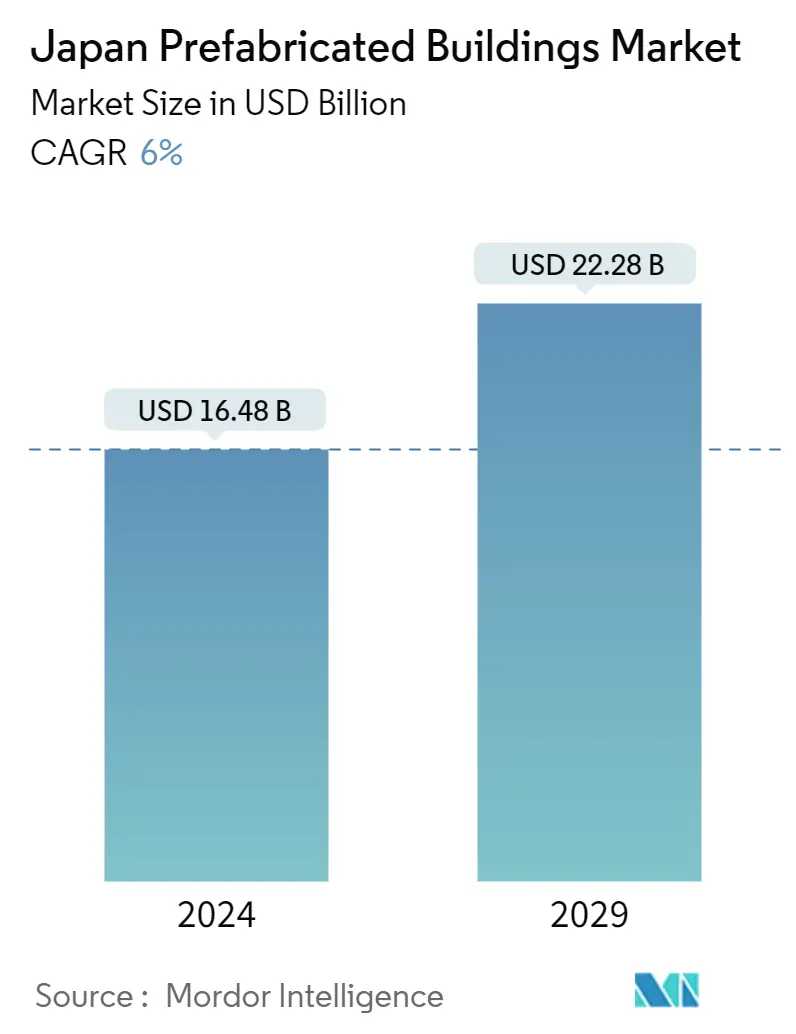Market Size of Japan Prefabricated Buildings Industry

| Study Period | 2020 - 2029 |
| Base Year For Estimation | 2023 |
| Market Size (2024) | USD 16.48 Billion |
| Market Size (2029) | USD 22.28 Billion |
| CAGR (2024 - 2029) | 6.00 % |
| Market Concentration | High |
Major Players_-_Copy.webp)
*Disclaimer: Major Players sorted in no particular order |
Japan Prefabricated Buildings Market Analysis
The Japan Prefabricated Buildings Market size is estimated at USD 16.48 billion in 2024, and is expected to reach USD 22.28 billion by 2029, growing at a CAGR of 6% during the forecast period (2024-2029).
Prefabricated housing accounted for approximately 13.1% of the total residential construction starts in Japan in 2022, with construction works initiated for nearly 112,5 thousand new housing units. This represents a decrease of approximately 0.8% from 2021.
Japan's prefab housing development has evolved into very advanced results. Today, Japanese prefab houses are built to high standards in terms of disaster resilience, thermal insulation, and bespoke designs.
Prefabricated buildings are typically designed to last 50 to 100 years, but Japanese families that use them rebuild their houses every 30 years because they view them as depreciating. Prefabricated construction has been around for a long time in many countries, but it has become increasingly popular in recent years. Japan has developed its prefabricated market by taking advantage of synergies with other industries. The inspections are carried out by industry-specific, trained professionals, rather than according to a general building code.
Japan Prefabricated Buildings Industry Segmentation
The Japan Prefabricated Buildings Market covers the growing trends and projects in prefab building markets, like commercial construction, residential construction, and industrial construction. The report also covers the industry along with the type of material used, like concrete, timber, glass, metal, and other types. Along with the scope of the report also it analyses the key players and the competitive landscape in the Japan Prefabricated Buildings Market. The impact of COVID'19 has also been incorporated and considered during the study.
Japan's Prefabricated Buildings Industry is segmented by Material Type (Concrete, Glass, Metal, Timber, and Other Material Types) and Application (Residential, Commercial, and Other Applications (Infrastructure and Industrial). The report offers market size and forecast for all the above segments in value (USD).
| Material Type | |
| Concrete | |
| Glass | |
| Metal | |
| Timber | |
| Other Material Types |
| Application | |
| Residential | |
| Commercial | |
| Other Applications ( Industrial, Institutional, and Infrastructure) |
Japan Prefabricated Buildings Market Size Summary
The Japan Prefabricated Buildings Market is poised for significant growth, driven by advancements in construction technology and changing societal attitudes towards housing. Prefabricated housing has become a notable segment of the residential construction sector, with Japanese prefab homes renowned for their high standards in disaster resilience and thermal insulation. The market is characterized by a unique cultural approach where homes are viewed as temporary structures, leading to a cycle of demolition and reconstruction every few decades. This "scrap and build" policy, coupled with the declining population and increasing number of vacant homes, has spurred the demand for prefabricated buildings as a solution to urban decay and infrastructure maintenance challenges. The market is also witnessing a shift as major players like Panasonic Homes and Toyota Home expand into new segments, such as wooden housing, to capture emerging opportunities.
The competitive landscape of the Japan Prefabricated Buildings Market is marked by the presence of several key players, including Sekisui House, Daiwa House Group, and Shimizu Corporation, who are not only dominating the domestic market but also expanding their reach internationally. As the domestic demand for new construction wanes due to demographic shifts, these companies are strategically targeting growth in other Asian markets. Innovations in design and functionality, such as Muji's latest prefab homes aimed at the aging population, reflect the industry's adaptability to changing consumer needs. The market's fragmentation and the entry of new players into various housing segments indicate a dynamic environment with potential for continued expansion and diversification in the coming years.
Japan Prefabricated Buildings Market Size - Table of Contents
-
1. MARKET INSIGHTS
-
1.1 Current Market Scenario
-
1.2 Technological Trends
-
1.3 Insights on Supply Chain/Value Chain Analysis of the Prefabricated Buildings Industry
-
1.4 Brief on Different Structures Used in the Prefabricated Buildings Industry
-
1.5 Cost Structure Analysis of the Prefabricated Buildings Industry
-
1.6 Government Regulations
-
1.7 Impact of COVID 19
-
-
2. MARKET SEGMENTATION
-
2.1 Material Type
-
2.1.1 Concrete
-
2.1.2 Glass
-
2.1.3 Metal
-
2.1.4 Timber
-
2.1.5 Other Material Types
-
-
2.2 Application
-
2.2.1 Residential
-
2.2.2 Commercial
-
2.2.3 Other Applications ( Industrial, Institutional, and Infrastructure)
-
-
Japan Prefabricated Buildings Market Size FAQs
How big is the Japan Prefabricated Buildings Market?
The Japan Prefabricated Buildings Market size is expected to reach USD 16.48 billion in 2024 and grow at a CAGR of 6% to reach USD 22.28 billion by 2029.
What is the current Japan Prefabricated Buildings Market size?
In 2024, the Japan Prefabricated Buildings Market size is expected to reach USD 16.48 billion.

